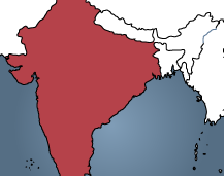The account of the Suttee represented in the engraving, is from the pen of the Rev. J. England, of Bangalore, under the Madras Presidency, in June 1826.
I received a note from a gentleman that a Suttee was about to take place near his house. On hastening to the spot, I found the preparations considerably advanced, and a large concourse of spectators assembled. On my left stood the horrid pile; it was an oblong bed of dry cow-dung cakes, about ten feet long, seven wide, and three high. At each corner of it, a rough stake, about eight feet in length, was driven into the ground, and about a foot from the top of these supporters was fastened, by cords, a frame of the same dimensions as the bad, and forming a canopy. This frame must have been of considerable weight; it was covered with very dry small faggots, which the officiating Brahmuns continued to throw upon it, till they rose two feet above the frame-work. On my right, sat the poor deluded widow, who was to be the victim of this heart-rending display of Hindoo purity and gentleness; she was attended by a dozen or more Brahmuns; her mother, sister, and son (an interesting boy of about three years of age), and other relatives were also with her. Her own infant, now twelve months old, was craftily kept from her by the Brahmuns. She had already performed a number of preparatory ceremonies; one of which was washing herself in a strong decoction of saffron, which is supposed to have a purifying effect. It imparted to her a horrid ghastliness; —her eyes indicated a degree of melancholy wildness; an unnatural smile now and then played on her countenance: and everything about her person and her conduct indicated that narcotics had been administered in no small quantities. Close by me stood the Fousdar, a native officer, who, besides regulating the police, is the chief military officer of the station. So heartily did he engage in this murderous work, that he gave the poor widow twenty pagodas (between six and seven pounds sterling), to confirm her resolution to be burned!
The Rev. Mr. Campbell addressed her in the Carnatic language, but the effect of his address was counteracted by the influence of the Brahmuns. The pile being completed, a quantity of straw as spread on the top. An increase of activitiy was soon visible among the men, whose ‘feet are swift to shed blood.’ Muntrams having been repeated over the pile, and the woman and every thing being in readiness, the hurdle to which the corpse of the husband had been fastened was now raised by six of the officiating Brahmuns; the end of a cord about two yards long, attached at the other end to the head of the bier, was taken by the widow, and the whole moved slowly towards the pile. The corpse was laid on the right side, and four men furnished with sharp swords, one stationed at each corner, now drew them from their scabbards. The trembling, ghastly offering to the Moloch of Hindoism, then began her seven circuits round the fatal pile, and finally halted opposite to her husband’s corpse, at the let side of it, where she was evidently greatly agitated. Five or six Brahmuns began to talk to her with much vehemence, till, in a paroxysm of desperation, assisted by the Brahmuns, the hapless widow ascended the bed of destruction. Her mother and her sister stood by, weeping and agonized; but all was in vain—the blood-thirsty men prevailed. The devoted woman then proceeded to disengage the rings from her fingers, wrists, and ears; her murderers streaching out their greedy hands to receive them: afterwards all her trinkets, &c., were distributed among the same relentless and rapacious priests. While in the act of taking a ring from her ear, her mother and sister, unable any longer to sustain the extremity of their anguish, went up to the side of the pile, and entreated that the horrid purpose might be abandoned; but the woman fearing the encounter, without uttering a word, or even casting a parting glance at her supplicating parent and sister, threw herself down on the pile, and clasped the half-putrid corpse in her arms. Straw in abundance was heaped on the dead and the living; guns, resin, and other inflammable substances were thrown upon the straw which covered the bodies, while muntrams were prepeated at their head; six or eight pieces of kindled cow-dung were introduced among the straw, at different parts of the pile; ghee and inflammable materials were applied, and the whole blazed in as many places. The men with swords at each corner then hacked the cords, which supported the canopy of faggots—it fell and covered the lifeless corpse and the living woman! A piercing sound caught my ear; I listened a few seconds, and, notwithstanding the noise of the multitude, heard the shrieks of misery which issued from the burning pile. In an agony of feeling, we directed the attention of the Brahumns to this; and while so doing, again—still louder and more piercing than before—the burning woman rent the air with her shrieks! Several of the Brahmuns called out to the half-consumed, still conscious and imploring widow, TO COMFORT HER! The pile was now enveloped in flames, and so intense was the heat, that, as by one consent, the Brahmuns and spectators retreated several paces; they then sang a Sanscrit hymn; the hymn ended, but not the shrieks and groans of the agonized sufferer; they still pierced our ears, and almost rent our hearts! Scarcely conscious of what I did, I left this fiendish barbarity.


